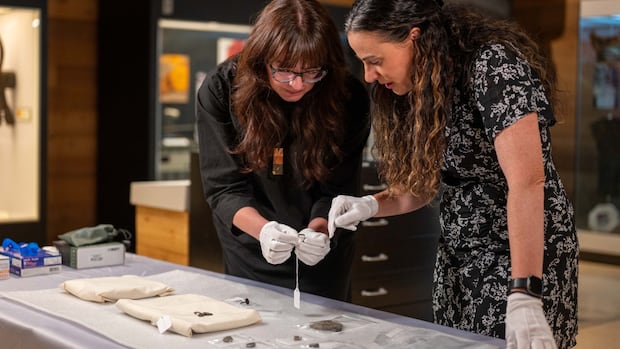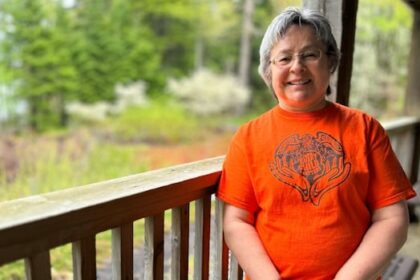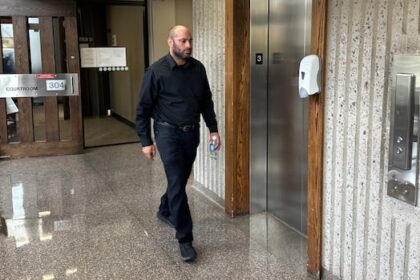British ColumbiaThrifty Boutique in Chilliwack, B.C., initially priced the artifacts at $30 each, but when a shopper who was well-versed in archaeology stumbled across the items, he alerted a shop volunteer to their possible significance.Rings and medallions are now in care of Simon Fraser UniversityBrieanna Charlebois · The Canadian Press · Posted: Sep 24, 2025 10:25 PM EDT | Last Updated: 7 hours agoSabrina Higgins, associate professor of global humanities and archaeology, and Barbara Hilden, director of Simon Fraser University’s Museum of Archaeology and Ethnology, examine the rare artifacts that have been donated to SFU for study from a Chilliwack, B.C., thrift store. (Sam Smith/Simon Fraser University)Sandy Parker has come across some interesting donations in her 11 years as manager of Thrifty Boutique in Chilliwack, B.C.That list has included a diamond ring that was hidden away in a sock and a flowery urn labelled “Mom’s ashes” that they are trying to return to the rightful owner. But she says the winner for most exciting find goes to the 11 rings and two medallions that were donated in the spring of 2024 and are believed to be medieval or Roman artifacts, potentially dating back thousands of years.”Absolutely it’s the most interesting thing that we’ve seen, just because of the history and the unknown,” Parker said in an interview on Wednesday. The boutique initially priced the artifacts at $30 each, but a patron who identified himself as an archaeologist stumbled across the items and alerted a volunteer about their possible significance. The unknown man suggested they contact Simon Fraser University, Parker said.”So, that’s what we did,” she said. Thrifty Boutique in Chilliwack, B.C., had originally priced the items at $30 each, before it was notified of their value by an unknown man. (Museum of Archaeology and Ethnology/Simon Fraser University)The collection has been donated to the university’s Museum of Archaeology and Ethnology, and will soon be used as part of a new course, where students get to analyze the designs and materials in an attempt to identify where they originated.Sabrina Higgins, an associate professor of archaeology at the university, was the first to look over the items and said in an interview that she believes, based on their decorations, that they could date back to the fourth or fifth century.She said rings are very common items to be found while excavating an archaeological site, but “for them to be found in a thrift store is, I think, on the rare side.””What’s really important is that the thrift store recognized the archaeological importance of that material, and it’s rare that they would have contacted us, to make sure that those belongings were housed somewhere appropriately and can be studied effectively,” she said.Some of the artifacts that have been donated to SFU for study include rings and medallions, which could be Roman or medieval. (Sam Smith/Simon Fraser University)Barbara Hilden, director of the Museum of Archaeology and Ethnology, said it does not typically collect items that lack the proper documentation, as there is a risk that they may have been illegally looted.”(It) took about a year from the time we first made contact to the time we formally accepted them in the museum,” she said of the artifacts.Hilden said the delay was caused by several ethical questions around where the items originated, who owned them and how they acquired them.The thrift store has no record of who donated them.”We really need to know exactly where it came from in order for it to have research value for our students and our faculty,” Hilden said. “Something like this, though, was just such a curious sort of one-off case.”It is still unknown who donated the items to the thrift store. (Sam Smith/Simon Fraser University)She said a main consideration was their potential fate if the museum declined the donation.”Part of the other conversations we had was, if we decline to accept this, do they get sold on eBay, or do they go into the private antiquities market, and is that better than having them be in the care of a museum which has a public trust responsibility?” Hilden said. Hilden said if they did accept the artifacts, that would mean the museum “will provide care and not monetize them, and we will keep them … [and] our students and researchers can learn from them.””And so ultimately, that’s what we decided,” she said.Parker said she was thrilled when the museum finally accepted the items and she’s now looking forward to learning more about the artifacts.The museum has promised to keep them updated, she said. “It’ll be interesting to see what happens.”Higgins, who will help teach the undergraduate course starting next fall, said the class will culminate in an exhibition at the museum, which will focus on the history and biography of the artifacts, as well as the ethical considerations that archaeologists and museums face.She said even if the artifacts end up being forgeries, it will still provide a unique learning experience for students and raise questions around why fakes continue to make their way into the antiquities market.Hilden agreed, saying that regardless of what the researchers find, the artifacts will remain at the museum indefinitely. “If they turn out to be modern forgeries, or even if they turn out to be not as old, as medieval, we’ll still keep them and talk about the research that enabled us to tell that story because that’s a valid part of the conversation.”
B.C. thrift store doesn’t know who donated possible medieval artifacts










